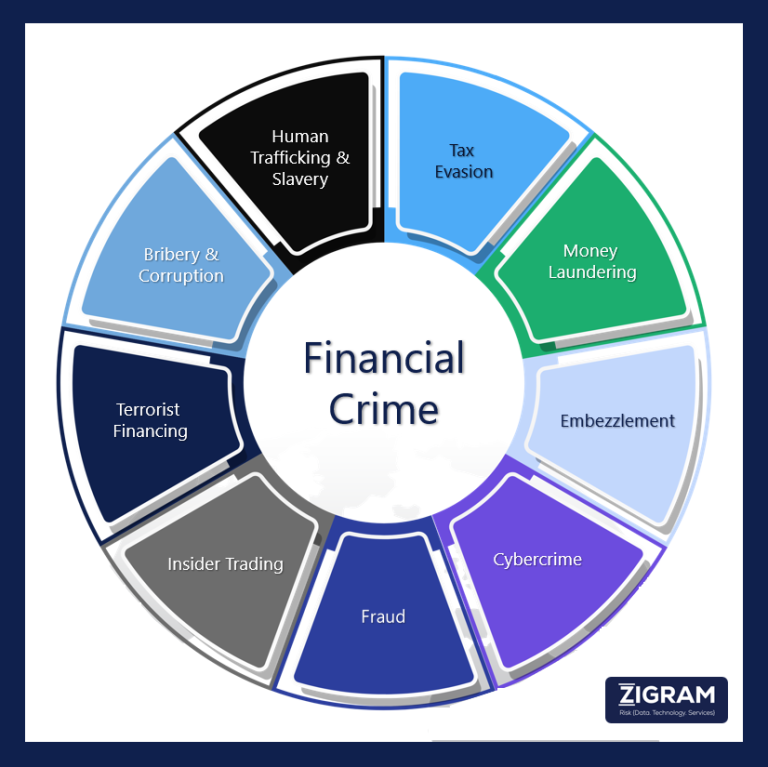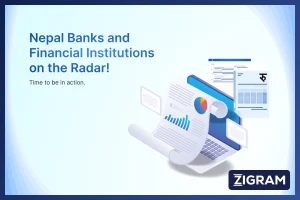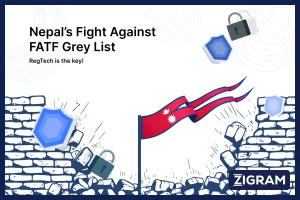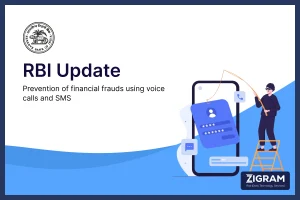Financial crime is apparently deeply entrenched and very complex, with any given case likely to affect one individual, businesses, or a whole economy. Examples of the different types and severities of financial crime include fraud, money laundering, terrorism financing, and insider trading. These risks strike back, and FCC has become a major framework that holds institutions liable under a tough set of rules and best practices. This article will explore the core aspects of financial crime, its variants, and some of the compliance frameworks, as set by the U.S. Financial Crimes Enforcement Network among others, which secure institutions and international economies.

What Is Financial Crime?
Financial crimes are a diversity of illegal acts committed for financial benefit. The crime is often throttled by organized groups, individuals, or corporate practitioners exploiting loopholes within a financial system for personal benefit at the cost of others.
Types Of Financial Crimes: A Closer Look

Financial institutions are vulnerable to a broad spectrum of financial crimes. Here are the primary types that demand stringent compliance measures:
1. Money Laundering
Money laundering is a way to hide illegal funds. It involves placement, layering, and integration into the financial system through which funds are given a legitimate appearance. It is speculated that a total amount ranging from $800 billion to $2 trillion is being laundered every year worldwide, which accounts for almost 5% of the world's gross domestic product.
2. Terrorist Financing
This involves using financial resources to fund terrorist activities, often through complex networks and legal businesses, making detection challenging for financial institutions.
3. Fraud
Encompassing identity theft, credit card fraud, and Ponzi schemes, fraud affects individuals and institutions alike. In 2022 alone, 47% of global organizations reported fraud losses amounting to $42 billion
4. Cybercrime
Cybercrime includes phishing, ransomware, and hacking. With global costs estimated to reach $10.5 trillion annually by 2025, cybercrime is among the fastest-growing threats of our times.
5. Bribery And Corruption
Bribery and corruption destroy trust and fairness in public and private life, comprising almost 70% of the financial crime fines doled out over the past several years.
6. Tax Evasion
Apart from illegitimate ways of evading tax, this denies governments of revenues which are required, thus resulting in huge impacts on public resources globally.
7. Embezzlement
The theft or acts of misappropriation of money placed under one's care within an organization, embezzlement hurts the business and nonprofits
8. Market Abuse And Insider Trading
These crimes include using inside information to present financial gains that distort markets and aspirate investor confidence.
9. Human Trafficking And Slavery
There is an interlink between financial crimes where traffickers make proceeds through the exploitation of people, and there should be increased scrutiny by financial institutions to identify suspicious activity reporting about this area globally.
Global Financial Crime Statistics
Financial crime has an overwhelming global impact, with costs exceeding $3.5 trillion annually. Key insights into these financial and regulatory challenges include:
- Money Laundering: Approximately $800 billion to $2 trillion is laundered globally each year, making up about 2-5% of global GDP. Source: UN office Drugs and Crimes
- Fraud: In 2022, nearly 47% of organizations reported experiencing fraud, resulting in global losses amounting to $42 billion. Source: PWC Report
- Sanctions Violations: Violations of global sanctions led to $5 billion in fines in 2023, with major institutions facing significant penalties.
- Anti-Money Laundering (AML) Fines: Financial institutions worldwide incurred $10.6 billion in AML compliance fines in 2020, up from $8 billion the previous year. Check our Report on Top 10 Penalties of 2023.
Regional Financial Crime Statistics
- United States: In 2022, the Financial Crimes Enforcement Network (FinCEN) received 2.7 million Suspicious Activity Reports (SARs), underscoring the prevalence of financial crime in the U.S.
- Europe: Fines for AML breaches in the European Union surpassed €2.5 billion in 2022, with substantial penalties in the UK, Germany, and France.
- Asia-Pacific: In 2020, 45% of organizations in the region experienced some form of financial crime.
Industry-Specific And Cyber-Related Financial Crime Statistics
- FinTech: In the FinTech sector, 56% of companies cited money laundering as a primary compliance concern.
- Cryptocurrency: In 2022, $10 billion was laundered through cryptocurrency channels, marking an increase from $6.6 billion the previous year.
- Cybercrime: Global cybercrime costs, including financial crimes, are projected to reach $10.5 trillion annually by 2025, with business email compromise alone accounting for $2.4 billion in losses in 2022.
These statistics highlight the critical need for Financial Crime Compliance (FCC) frameworks to protect the financial system from these growing threats.
Related Reads: Access global reports and analysis
Financial Crime Compliance (FCC): An Essential Framework
This points out the urge for Financial Crime Compliance frameworks that will help defend the financial system against these increasingly heinous threats. With the pervasiveness and increasing influence of financial crimes, most banks nowadays increasingly seek to adopt an FCC framework. An FCC framework lends credence to institutions in their compliance with policies directed toward the effective detection, prevention, and reporting of unlawful activities. Regulated by competent authority such as FinCEN among others, these frameworks detail the prescribed best practices that all financial institutions ought to adhere to ensure compliance, stability, and public trust in the financial system.
Importance Of Financial Crime Compliance (FCC)
1. Protecting Against Financial Crimes
FCC acts as the first line of defense against illegal activities such as money laundering, fraud, and terrorist financing. By implementing policies and internal controls, institutions can mitigate financial crime risks.
2. Meeting Regulatory Obligations
Compliance is not optional; financial institutions must adhere to stringent local and international regulations. Non-compliance can lead to hefty fines and severe reputational damage, as seen in global fines totaling $9.95 billion in 2021
3. Building Trust And Protecting Reputation
Compliance with financial crime regulations reinforces an institution’s commitment to ethical practices, preserving customer trust and protecting the brand.
4. Adapting To Emerging Risks
With the rise of digital transactions and cybercrime, FCC frameworks must evolve, incorporating advanced technologies like AI, machine learning, and blockchain to identify and prevent new forms of crime
Key Components Of Financial Crime Compliance Program
A well-rounded FCC program will have some key elements
1. Adverse Media and Sanctions Screening
Screening customers against sanctions lists and monitoring adverse media are really the bedrock of any financial crime compliance program, as it allows institutions proactively to identify individuals and entities presenting them with a threat. During sanctions screening, customer information is matched against relevant international watch lists, including those prepared by the U.S. Office of Foreign Assets Control, the European Union, and the United Nations.
On the other hand, adverse media screening screens publicly available information for any negative news about misdeeds related to financial crimes or other crimes. Blended together, these practices prevent high-risk entities from infiltrating the financial system and protect institutions from regulatory breaches or monetary fines.
2. AML and PEP Screening
AML screening works toward finding suspicious patterns respect to transactions, like structuring or layering, wherein criminals mask the source of illicit funds. In contrast, PEP screening identifies persons holding high-ranking public positions who are susceptible to fall prey to corruption status. It is with strong AML and PEP screening in place that entities not only gain resistance against financial crime but also follow the regulatory standards put forward by organizations such as the Financial Action Task Force. These practices are essential in maintaining the financial system's integrity, enhancing public trust, and minimizing regulatory exposure.
3. Risk Assessment
Regular risk assessments allow financial institutions to evaluate potential vulnerabilities in their customer base, transactions, and overall business activities. By identifying and categorizing these risks, organizations can tailor their compliance strategies and allocate resources effectively. The entities of risk assessments include geography, customer type, product use, and transaction behavior, which enable organizations to recognize risky activities that require additional control.
For instance, transactions made in regions linked to financial crimes or with high-risk customers need to be monitored more carefully. And as crime patterns evolve—such as the increased use of digital banking or cryptocurrency—institutions must equally evolve their risk assessments to meet current threats.
4. Reporting and Record-Keeping
Regulatory agencies demand that financial institutions do detailed recording of transactions and report suspicious activity via the Suspicious Activity Report system. SARs portray unusual activity, like activities out of range for a typical account or abnormal patterns. This gives immense insight into the regulatory agencies and law enforcement in investigating any form of possible criminal activity.
Proper recordkeeping develops an audit trail that might come in handy when an institution needs to prove how compliant it has been in matters concerning its regulatory reviews. In that way, the documentation allows organizations to play their role in the broader fight against financial crime by facilitating investigations and enhancing system transparency and integrity.
5. Staff Training
Regular training imparts the necessary knowledge in the staff to identify, report, and respond to suspicious activities. Various topics are covered in such training programs, which include AML principles, identification and handling of high-risk customers, and filing of SARs. Continuous education will also help staff to be more informed about the growing tactics of crime, regulatory changes, and emerging technologies in the field, such as AI in compliance.
When employees can understand the risks and recognize signs of potential criminal behavior, they add to the resilience of the organization against financial crime, contributing toward stakeholder safety in a secure financial environment.
ZIGRAM’s Solutions For Financial Crime Compliance
ZIGRAM is a RegTech leader providing AI-driven solutions for compliance and risk management. With platforms like PreScreening.io for name screening, Transact Comply for transaction monitoring, Entity Hero for risk assessment, and Dragnet Alpha for adverse news monitoring, ZIGRAM enables institutions to streamline FCC processes. Our DueDiliger platform offers due diligence reports, and AML Penalties provides real-time insights into global AML events and penalties.
Additionally, ZIGRAM’s extensive data assets, including Country Watchlists, Sanctions Shield and Crypto Entities, enhance organizations’ ability to monitor high-risk entities. With these cutting-edge solutions, ZIGRAM enables financial institutions to navigate complex regulatory environments, manage risk proactively, and maintain compliance in an increasingly digital and interconnected world.
Explore Our solutions here- Solutions and Book a Demo to know more!
- #aml
- #cft
- #India
- #FATF
- #MutualEvaluationReport2024






